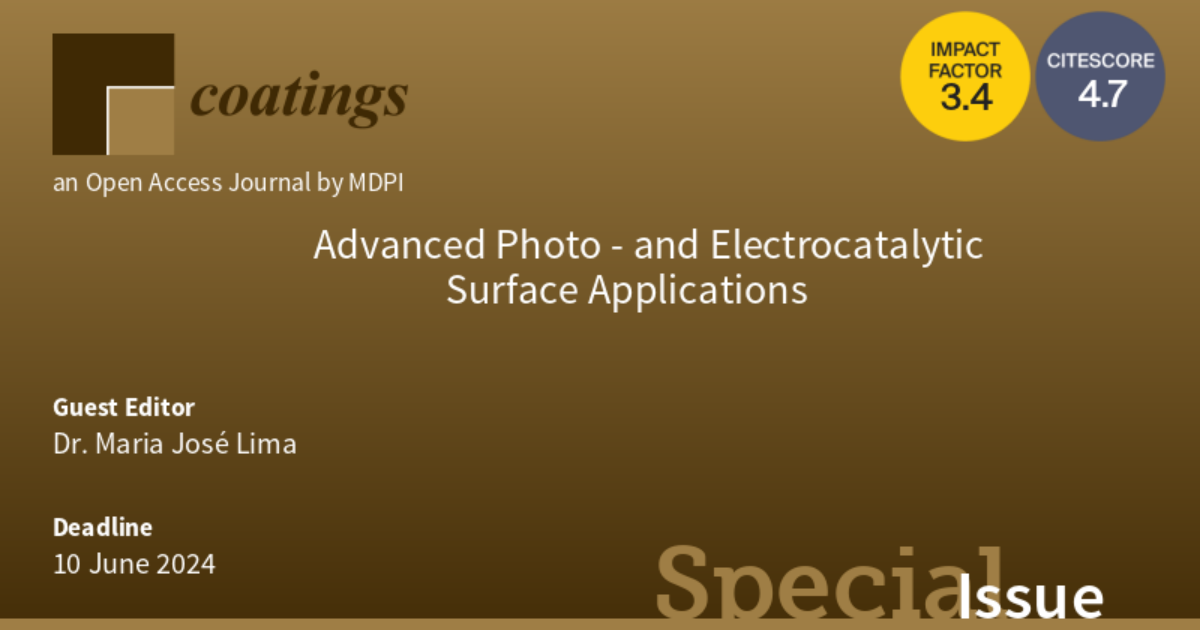Advanced Photo- and Electrocatalytic Surface Applications
A special issue of Coatings (ISSN 2079-6412). This special issue belongs to the section "Surface Engineering for Energy Harvesting, Conversion, and Storage".
Deadline for manuscript submissions: closed (10 June 2024) | Viewed by 5947

Special Issue Editor
Special Issue Information
Dear Colleagues,
Energy transition and green processes are included in the 2030 Sustainable Development Goals of the United Nations. Applications include wastewater treatment, CO2 reduction, H2 production, and chemical synthesis. Catalytic systems, in particular, photo- and electrocatalytic processes, are capitally important in the present economic and energetic context.
One of the biggest challenges of scaling-up catalytic processes is related to the use of catalysts in slurry. Immobilizing the catalyst can solve these problems, making it possible to reuse and avoid centrifugation/filtration steps after the reaction. However, immobilization strategies may fail in the reusability aspect if the catalytic particles detach from the support surface. It is, therefore, of the utmost importance to investigate immobilization techniques that are able to produce stable and adhered films with good catalytic activity.
We are pleased to invite you to publish in this Special Issue on photo- and electrocatalytic applications using catalysts in the form of coatings. This thematic is aligned with the journal scope, which includes publishing research on coatings and surface engineering.
This Special Issue aims to cover the photo- and electrocatalytic applications of coatings produced using diverse techniques. This includes physical/chemical vapor deposition, chemical functionalization, thermal and ultrasonic methods.
In this Special Issue, original research articles and reviews are welcome. Research areas may include, but are not limited to, the following: photocatalysis, electrocatalysis, thin films, chemical vapor deposition, physical vapor deposition, and chemical functionalization processes.
We look forward to receiving your contributions.
Dr. Maria José Lima
Guest Editor
Manuscript Submission Information
Manuscripts should be submitted online at www.mdpi.com by registering and logging in to this website. Once you are registered, click here to go to the submission form. Manuscripts can be submitted until the deadline. All submissions that pass pre-check are peer-reviewed. Accepted papers will be published continuously in the journal (as soon as accepted) and will be listed together on the special issue website. Research articles, review articles as well as short communications are invited. For planned papers, a title and short abstract (about 100 words) can be sent to the Editorial Office for announcement on this website.
Submitted manuscripts should not have been published previously, nor be under consideration for publication elsewhere (except conference proceedings papers). All manuscripts are thoroughly refereed through a single-blind peer-review process. A guide for authors and other relevant information for submission of manuscripts is available on the Instructions for Authors page. Coatings is an international peer-reviewed open access monthly journal published by MDPI.
Please visit the Instructions for Authors page before submitting a manuscript. The Article Processing Charge (APC) for publication in this open access journal is 2600 CHF (Swiss Francs). Submitted papers should be well formatted and use good English. Authors may use MDPI's English editing service prior to publication or during author revisions.
Keywords
- photocatalysis
- electrocatalysis
- catalysis
- coatings
- thin films
- chemical vapor deposition
- physical vapor deposition
- chemical functionalization
Benefits of Publishing in a Special Issue
- Ease of navigation: Grouping papers by topic helps scholars navigate broad scope journals more efficiently.
- Greater discoverability: Special Issues support the reach and impact of scientific research. Articles in Special Issues are more discoverable and cited more frequently.
- Expansion of research network: Special Issues facilitate connections among authors, fostering scientific collaborations.
- External promotion: Articles in Special Issues are often promoted through the journal's social media, increasing their visibility.
- e-Book format: Special Issues with more than 10 articles can be published as dedicated e-books, ensuring wide and rapid dissemination.
Further information on MDPI's Special Issue polices can be found here.





